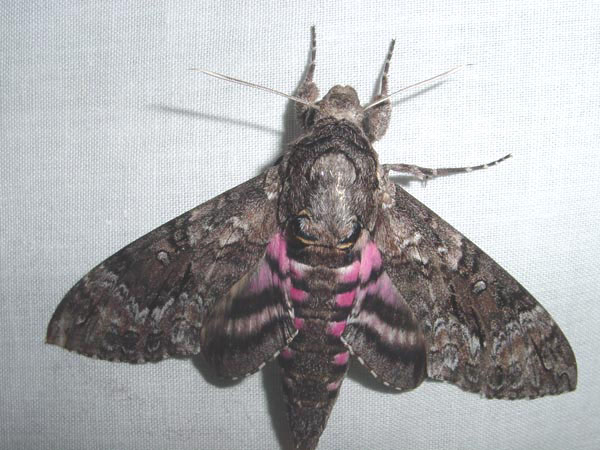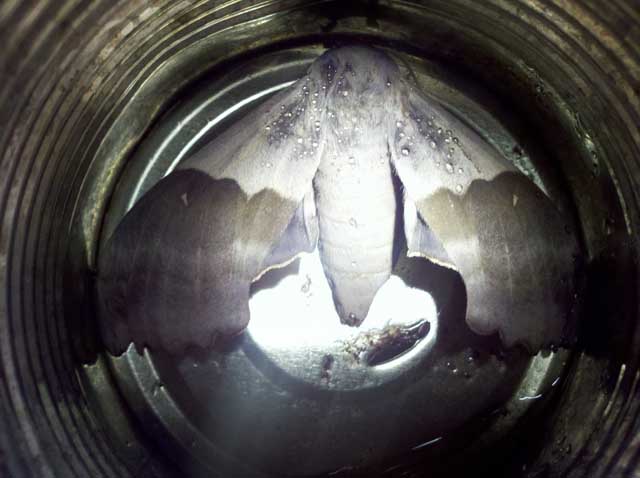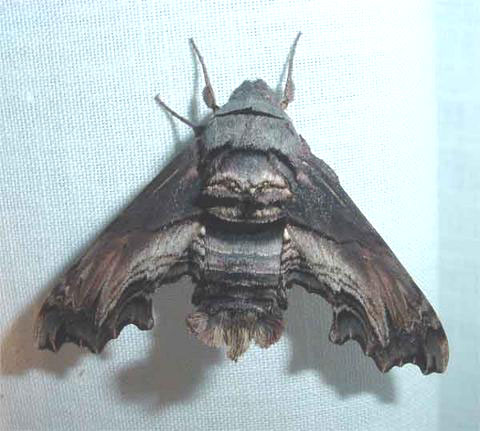Sphinginae subfamily
Sphingini tribe:
 |
This moth is a very strong flier, but would only make its way to
Monroe County as a rare stray. There are not too many records from
New York state, but records exist for NJ and CT.
BINGO!, but only as a very rare stray
|
Agrius cingulata, August 29, 2005, Steve Daniel
 |
Ceratomia amyntor WO,
the Elm Sphinx or Four-horned Sphinx
The upperside of the forewing is brown with dark brown and white markings including a white costal area near the wing base, dark streaks along the veins, and
a white spot in the cell.
|
 |
The upperside of the forewing is pale brownish gray with wavy black and white lines and a black-outlined white cell spot. The upperside of the hindwing is gray with diffuse darker bands.
|
Ceratomia undulosa, 6/6/04, Steve Daniel
 |
The upperside of the forewing is dark brown with a dusting of white scales. Some moths have patches of reddish or yellowish brown on the wings.
|
 |
This moth is not reported from Monroe, but it is
reported to the north, east, south and west. If you have pines, you
probably have this species. It flies on P.E.I.
|
 |
The upperside of the forewing is gray-brown with wavy lines, black dashes, and one or two small white spots near the center of the costa.
|
 |
Manduca quinquemaculatus SD/ WO,
the Five-spotted Hawkmoth
The moth abdomen usually has five but sometimes six pairs of yellow bands. The upperside of the forewing is blurry brown and gray.
I suspect if you grow tomatoes, you are likely to encounter it.
|
 |
Manduca sexta
SD/ WO, the Carolina Sphinx
The abdomen usually has six pairs of yellow bands, broken across the back. The sixth set of markings is quite small.
The upperside of the forewing has indistinct black, brown, and
white markings.
If you grow tomatoes, however, you may have encountered it as it has
been found in western N.Y.
|
 | The upperside of the forewing is gray with indistinct black and white markings. There is a series of black dashes
from the base to the tip, and a small white cell spot.
|

|
Sphinx canadensis
WO,
Sphinx canadensis, the Canadian Sphinx, is not common, and is not
often reported anywhere,
but it might be present in Monroe County as it is reported from
southern Ontario, Canada.
Larval hosts are white ash (Fraxinus americana) and blueberry
(Vaccinium).
|
 |
Sphinx chersis WO, the Northern Ash Sphinx or Great Ash Sphinx
This species is probably present but may not
be common. Larval hosts are ash, lilac, privet, cherry, and quaking aspen.
|
 |
This species is not officially reported in Monroe. We have them
on P.E.I., but I do not see them nearly as frequently
as I see the other Sphingidae.
|
 |
This species is not reported in Monroe. Generally it is
widely reported in neighbouring counties.
Note the pm line, absent in Sphinx poecila which generally flies
more to the north. |
 |
The lower forewings are predominantly brownish-yellow with a fairly wide dark bar along the inner margin. At rest the wings hug the body, giving the moth a long slender look.
|
Sphinx kalmiae, June 1, 2006, Pittsford, Steve Daniel
 |
Sphinx luscitiosa
WO,
the Canadian Sphinx or
Clemen's Sphinx
This one is not reported from Monroe County, but it has been seen to the
southeast. It is generally not common. possibility
|
 |
If you have blueberries in the woods, then you might have the
Poecila Sphinx.
They are pretty common here on Prince Edward Island. It has not been
confirmed in Monroe County. |
Smerinthini Tribe:
 |
The adults are also highly variable; sometimes wings of an individual may be all one color or may have several colors, ranging from pale to dark brown, and may have a white or pink tinge.
See the file for the female; she is different. |
 |
Pachysphinx modesta
WO/SD/JK,
the Modest Sphinx or Poplar Sphinx
This moth is now recorded in Monroe County by Steve Daniel. It is fond of poplars and
willows.
They are common on Prince Edward Island. |
Pachysphinx modesta, May 31, 2006, Pittsford, Steve Daniel
Pachysphinx modesta, May 21, 2009, Pittsford, Steve Daniel
Pachysphinx modesta, June 3, 2012, Joseph Korzenieski, via T. J. Korzenieski
 |
Named for the dull grey-blue spot (minus dark pupil) in the hindwing,
this moth has a wide distribution and is probably common in Monroe
County.
I regularly see them on Prince Edward Island, and they are reported
as far south as Florida. |
Paonias excaecata, July 17, 2008, 3:00 am, Steve Daniel
 |
Paonias myops SD/ WO, the Small-eyed Sphinx
Named for the small eye-spot in the hindwing, this moth has a wide distribution
and is probably common in Monroe County.
I regularly see them on Prince Edward Island, and they are reported as far south as Florida.
|
Paonias myops, 6/8/2004, Steve Daniel
Paonias myops, May 31, 2006, Pittsford, Steve Daniel
Paonias myops, May 23, 2007, Pittsford, Steve Daniel
Paonias myops, May 21, 2009, Pittsford, Steve Daniel
 |
Smerinthus cerisyi
WO,
the Cerisyi's Sphinx
Smerinthus cerisyi is found in the southern regions of all Canadian provinces and in northern border states. The one-eyed sphinx is also found along the U.S.
west coast, eastward to the Rockies. At my home in Montague, P.E.I., Canada, they are quite common.
|
 |
This moth is widely distributed and fairly common.
Along the East Coast, it flies from P.E.I. to Florida. I suspect it
is present. |
Smerinthus jamaicensis, June 9, 2004, Steve Daniel
Smerinthus jamaicensis May 25; June 7, 2006, Steve Daniel
Macroglossinae subfamily
Dilophonotini tribe:
See Hemaris comparison to help distinguish
the next three species.
 |
Hemaris thysbe
SD/WO, the Hummingbird Clearwing
It is not difficult to see why many gardeners would mistake an Hemaris thysbe moth for a small hummingbird as it hovers, sipping nectar from flowers through a
long feeding tube.
|
Hemaris thysbe, 8/8/02, Steve Daniel
 |
Hemaris diffinis
SD/ WO, the
Snowberry Clearwing or Bumblebee Moth
Adults mimic bumblebees and are quite variable. The wings are
basically clear, with dark brown to brownish-orange veins, bases
and edges. The thorax is golden-brown to dark greenish-brown with
1-2 yellow segments on the abdomen.
|
Hemaris diffinis, 6/7/05, Steve Daniel
 |
Hemaris gracilis WO, the
Slender Clearwing or Graceful Clearwing
This day-flying moth is less common and has not been recorded in
Monroe, but has been seen due east, south and west.
|
Philampelini tribe:
 |
This moth is not reported for Monroe, but it is fairly often reported
along the coast from southern New Jersey
to central Maine.
Note the differences between this moth and the Pandorus Sphinx. |
 |
If you have Grape or Virginia Creeper nearby, then you probably have
this species.
I often get asked to identify larvae from areas not
previously reported. Confirmed by Steve Daniel.
|
Eumorpha pandorus, larva, 1979, Steve Daniel
Eumorpha pandorus, adult, July 27, 2006, Steve Daniel
Macroglossini tribe:
 |
This day flier is widely distributed. If you have Virginia Creeper,
you probably have the Nessus Sphinx. It is now officially reported from
Monroe.
Two bright, distinct, narrow yellow
bands are often visible on the abdomen.
|
Amphion floridensis, Honeoye Falls, Monroe County, June 2, Steve Daniel
Amphion floridensis, Powder Mill Park, Town of Perinton, June 15, Steve Daniel
Amphion floridensis Auburn trail, northern Ontario city, June 1, Steve Daniel
 |
They are common in New Jersey and common
here on Prince Edward Island.
You will often see this species listed as Darapsa pholus,
especially in older literature.
It is not confirmed for Monroe,
but likely is present.
|
 |
Darapsa myron SD/WO, the Virginia Creeper Sphinx or the Grapevine Sphinx
This moth is not recorded on the U.S.G.S. site for Monroe County, but is confirmed by Steve Daniel.
It is widely reported as far north as southern Maine. If you have the
foodplants indicated in the common names, you probably have this
species nearby. |
Darapsa myron July 12, 2004 Steve Daniel
Darapsa myron, May 29, 2006, Steve Daniel
Darapsa myron (2), May 31; June 7, 2006, Pittsford, Steve Daniel
 |
If you have hydrangea growing near a stream, then you may have the
Hydrangea Sphinx. It has not been reported in Monroe,
but is likely there.
|
 |
This species has now been recorded in Monroe, courtesy of Steve
Daniel.
Larvae feed on grape foliage and on Virginia Creeper. |
Deidamia inscriptum 30 April 2006, 27 May 2005, Steve Daniel
Deidamia inscriptum, May 22, 2007, Pittsford, Steve Daniel
 |
Hyles gallii WO, the Bedstraw Hawk Moth
or Gallium Sphinx
This species is not reported in Monroe, but I suspect it is there.
Some years I see them on P.E.I., some years, I do not.
|
 |
Hyles lineata WO, the White-lined Sphinx
This species is not reported from Monroe County. It flies across
southern New York and has strong migrating tendancies.
There are records from New Hampshire and Maine.
|
 |
This moth is very much under reported across the United States. It
is a rapid day flier so is probably not in too many collections.
Grape is a popular larval host.
It is now confirmed for Monroe,
by Steve Daniel.
|
Sphecodina abbottii, May 8, 2006; May 14, 2007, Steve Daniel.
Sphecodina abbottii, May 29, 2009, Pittsford, Steve Daniel.
|
|



